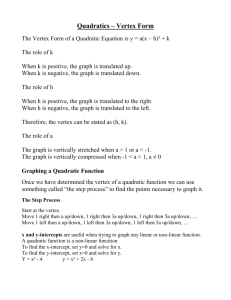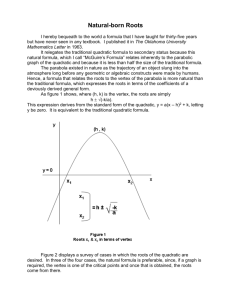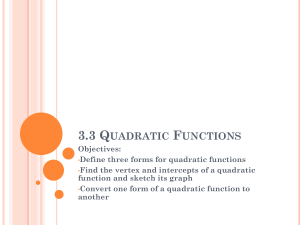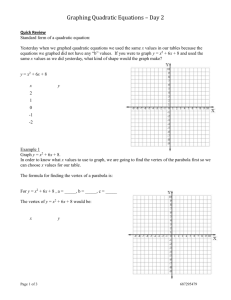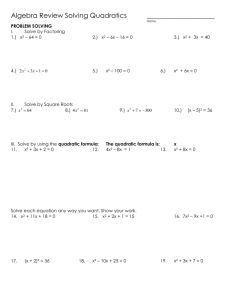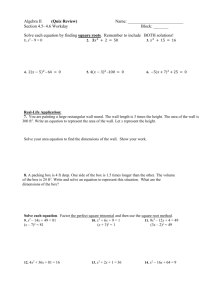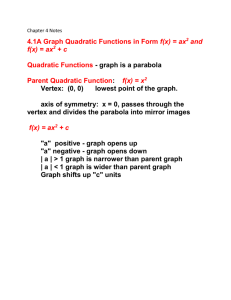File
advertisement
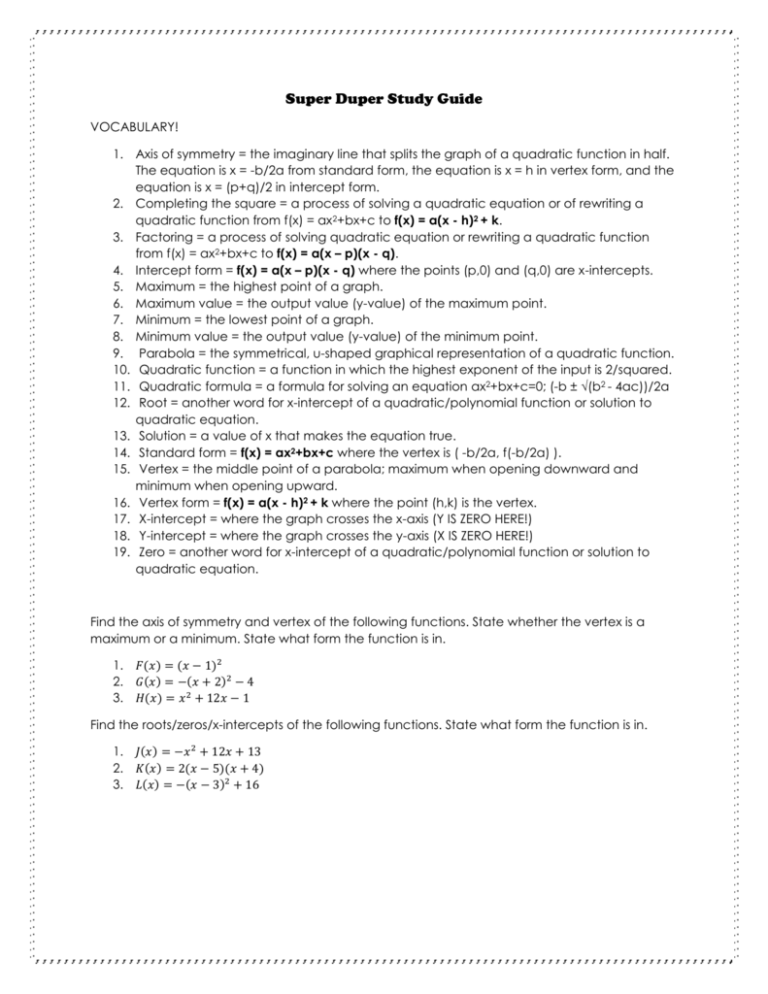
Super Duper Study Guide VOCABULARY! 1. Axis of symmetry = the imaginary line that splits the graph of a quadratic function in half. The equation is x = -b/2a from standard form, the equation is x = h in vertex form, and the equation is x = (p+q)/2 in intercept form. 2. Completing the square = a process of solving a quadratic equation or of rewriting a quadratic function from f(x) = ax2+bx+c to f(x) = a(x - h)2 + k. 3. Factoring = a process of solving quadratic equation or rewriting a quadratic function from f(x) = ax2+bx+c to f(x) = a(x – p)(x - q). 4. Intercept form = f(x) = a(x – p)(x - q) where the points (p,0) and (q,0) are x-intercepts. 5. Maximum = the highest point of a graph. 6. Maximum value = the output value (y-value) of the maximum point. 7. Minimum = the lowest point of a graph. 8. Minimum value = the output value (y-value) of the minimum point. 9. Parabola = the symmetrical, u-shaped graphical representation of a quadratic function. 10. Quadratic function = a function in which the highest exponent of the input is 2/squared. 11. Quadratic formula = a formula for solving an equation ax2+bx+c=0; (-b ± √(b2 - 4ac))/2a 12. Root = another word for x-intercept of a quadratic/polynomial function or solution to quadratic equation. 13. Solution = a value of x that makes the equation true. 14. Standard form = f(x) = ax2+bx+c where the vertex is ( -b/2a, f(-b/2a) ). 15. Vertex = the middle point of a parabola; maximum when opening downward and minimum when opening upward. 16. Vertex form = f(x) = a(x - h)2 + k where the point (h,k) is the vertex. 17. X-intercept = where the graph crosses the x-axis (Y IS ZERO HERE!) 18. Y-intercept = where the graph crosses the y-axis (X IS ZERO HERE!) 19. Zero = another word for x-intercept of a quadratic/polynomial function or solution to quadratic equation. Find the axis of symmetry and vertex of the following functions. State whether the vertex is a maximum or a minimum. State what form the function is in. 1. 𝐹(𝑥) = (𝑥 − 1)2 2. 𝐺(𝑥) = −(𝑥 + 2)2 − 4 3. 𝐻(𝑥) = 𝑥 2 + 12𝑥 − 1 Find the roots/zeros/x-intercepts of the following functions. State what form the function is in. 1. 𝐽(𝑥) = −𝑥 2 + 12𝑥 + 13 2. 𝐾(𝑥) = 2(𝑥 − 5)(𝑥 + 4) 3. 𝐿(𝑥) = −(𝑥 − 3)2 + 16 PRACTICE! Solve the following using the given method. 1. 2. 3. 4. 5. 2𝑥 2 − 10𝑥 − 48 = 0 by factoring 𝑥 2 − 6𝑥 − 112 = 0 by completing the square 3𝑥 2 + 15𝑥 − 42 = 0 by using the quadratic formula 2𝑥 2 + 20 = 𝑥 2 + 120 by taking the square root 3𝑥 2 + 7𝑥 + 4 = 0 by any method Graph the following functions. 6. 𝐹(𝑥) = (𝑥 + 2)(𝑥 − 5) 7. 𝐺(𝑥) = (𝑥 + 5)2 + 4 1 8. 𝐻(𝑥) = − 2 (𝑥 + 3)(𝑥 + 5) 9. 𝐽(𝑥) = −3𝑥 2 − 6𝑥 + 24 10. 𝐾(𝑥) = −2(𝑥 − 1)2 + 3 Answer the following questions about falling objects and maximization/ minimization. 11. An object is launched at 19.6 meters per second (m/s) from a 58.8-meter tall platform. The equation for the object's height s at time t seconds after launch is s(t) = –4.9t2 + 19.6t + 58.8, where s is in meters. When does the object strike the ground? 12. An object in launched directly upward at 64 feet per second (ft/s) from a platform 80 feet high. What will be the object's maximum height? When will it attain this height? 13. The number of bacteria in a refrigerated food is given by N(T) = 20T2 – 20T + 120, for − 2 ≤ T ≤ 14 and where T is the temperature of the food in Celsius. At what temperature will the number of bacteria be minimal? 14. A manufacturer of tennis balls has a daily cost of C(x) = 200 −10x + 0.01x2 where C is the total cost in dollars and x is the number of tennis balls produced. What number of tennis balls will produce the minimum? What is the minimum cost? 15. A foul ball leaves the end of a baseball bat and travels according to the formula h(t) = 64t – 16t2 where h is the height of the ball in feet and t is the time in seconds. How long will it take for the ball to reach a height of 64 feet in the air?

